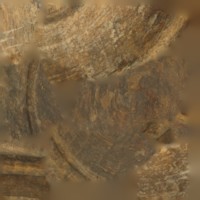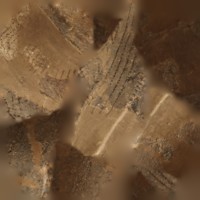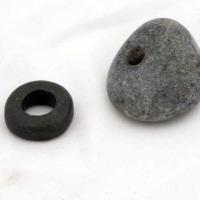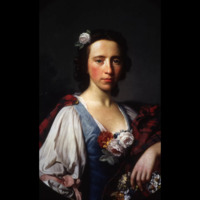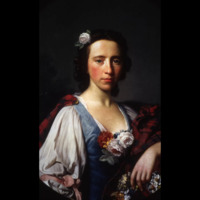Browse Items (112 total)
- Collection: Physical Object: Flora MacDonald's prayer book
Sort by:
Fort William gate lock
Large metal lock from Fort William.
Blog - The Artist Jon Schueler
Blog by Madga Salvesen, Curator Jon Schueler Estate
Poltalloch harp
This beautifully decorated clarsach, or Scottish harp is in the style of the Queen Mary harp, the original design of which dates from the reign of Mary Queen of Scots. This grand instrument is part of our Highland Life collection and the carved wood…
Stalker's telescope
This leather-bound stalker’s telescope has been selected because of its association with the Highlands. It is a typical example of equipment ghillies would use when deer stalking in the hills around the area. This telescope is particularly special as…
Golden Eagle
This fine taxidermy specimen of a golden eagle came to the museum in 1940. There is no record as to when it was prepared, but our records show that the eagle was captured in a trap in Glencoe. By today’s standards this specimen was obtained…
Spinning wheel
This spinning wheel used for spinning thread or yarn from fibres was made in the French pattern, and was gifted to the West Highland Museum along with spindles, whorls, and a bobbin. The objects are exceptional because of they are said to have once…
Charm stones
Charms were an integral part of Highland culture for centuries. There are a good variety of charms in the museum, covering everything from preventing nightmares, encouraging rain, and warding away evil spirits. Many were collected by the Victorian…
Lock of hair
The iconic Lochaber axe has been included in the gallery because it is still an important symbol of the area today, even appearing on the West Highland Museum’s logo. The Lochaber axe is a long-handled battle-axe used by the Highland foot soldier.…
Shoulder belt plate
This an early modern shoulder-belt plate that was found in 2015 by metal detectorists in the deserted township of Alisary. It is very rare because it is engraved "Moidart Volunteers" and little evidence remains of their existence. By 1800…
Clan Ranald banner
This 18th century banner contains the Coat of Arms of MacDonald of Moidart. By tradition this is Clanranald’s Banner which was raised beside the Standard of Prince Charles Edward Stuart at Glenfinnan and was on the battlefield at Culloden. Although,…
Camanachd Cup shinty medal
This is one of the oldest medals in competitive shinty. Shinty, or camanachd as it is traditionally known in the Gaelic-speaking West Highlands, is an ancient game. Introduced to Scotland along with Christianity and the Gaelic language nearly two…
Ben Nevis race medal
This Ben Nevis race medal was won by Lucy Cameron. She won the women’s race in 1902 in the record time of 2 hours and 3 minutes. The first competitive Ben Nevis race was held in 1898. Up until the turn of the century women were banned from the race,…
A. A. Cameron's championship belt
This was championship belt was won by strong man Alexander Anthony Cameron (1877–1951). He was one of the all-time great strongmen and athletes from Dochanassie in Lochaber. He was sometimes known as the Mighty Mucomir and was the greatest heavy of…
The Appin gun
This gun by tradition is the Appin murder weapon. The Appin murder took place on 14 May 1752 in the aftermath of the 1745 Jacobite Rising. It is an infamous and unsolved murder, and the story became the inspiration for Robert Louis Stevenson's novel…
Map of the forfeited lands
This map shows the estates belonging to Cameron of Lochiel that were forfeited after the 1745 uprising. Lochiel had led Clan Cameron throughout the Jacobite Rising and escaped into exile with Prince Charles Edward Stuart in 1746. Following the defeat…
Big Duncan Cameron's dirk
This heavy dirk with a backed blade is made from steel with a wooden hilt decorated with a Celtic knotwork design and brass pins. The dirk is important to the collection because of its connection to Big Duncan Cameron, known in Gaelic as Donnchadh…
Prince Charles Edward Stuart's trews
Royal Stewart sett hard tartan trews with integral 'feet'. Traditional trews were not trousers, but long hose which were worn high up to the waist. These are said to have belonged to Prince Charles Edward Stuart (1720 - 1788). The provenance has yet…
Snuff Mull
This is a silver baluster snuff mull with the heraldic arms of Cluny MacPherson set within a foliated scroll formed cartouche. The museum purchased the mull at auction in 2015 specifically for the Jacobite collection. This special object purportedly…
Prince Charles Edward Stuart's waistcoat
A pale green striped silk waistcoat that has been embroidered with rosebuds and silver thread. It is a textile with a fascinating history. The waistcoat once belonged to Prince Charles Edward Stuart (1720 - 1788). It was quite common for Charles to…
Miniatures of Prince Charles Edward Stuart
Three examples of portraits after the engraving by Robert Strange (1721 -1792). Strange’s engraving was based on the Allan Ramsay (1713 – 1784) portrait of Prince Edward Stuart painted in Edinburgh in 1745. Miniatures like these were copied and…
Portrait of the Gentle Lochiel
Portrait of Donald Cameron of Lochiel (1695–1748), ‘The Gentle Lochiel' in a gilt frame. Although this is a copy of a George Chalmers (1720–c.1791) original made 20 years after Lochiel’s death it is an important painting as very few images of the…
The Glenfinnan Stone
A large round boulder with a hole bored partially through it. This is a stone with an iconic history. It was originally from Glenfinnan and by tradition is thought to have been used to support the Standard of Prince Charles Edward Stuart when it was…
Culloden prayer book
A prayer book titled “A Manual for A Christian”. The prayer book was rebound in the 19th century when the inner and outer case were added. Sadly, no publication information survived this process. The book was gifted to the museum in 2018. It is…
Two-sided Chair
A two-sided chair with an embroidered velvet seat said to have been used by Prince Charles Edward Stuart (1720 - 1788). The embroidered inscription reads “August 23 1745 Prince Charles Edward stayed the first night of his march to Inverness with John…
Lord Lovat's spectacles
Tortoiseshell framed spectacles with a leather case said to have belonged to Lord Lovat. Simon Fraser, 11th Lord Lovat, (1667 – 1747) was chief of clan Fraser, and a Jacobite nicknamed the ‘Old Fox’ for his double-dealings, violent feuds and changes…
Flora MacDonald's tea cup
Bone china fluted handle less tea cup and deep saucer said to have been part of a set that belonged to Flora MacDonald (1722 -1790).
Flora MacDonald's shoe buckles
A pair of decorative 18th century shoe buckles with paste 'jewels'. Said to have been worn by Flora MacDonald (1722 -1790).
Flora was a heroine of the 1745 Jacobite Rising. After two months on the run, Prince Charles Edward Stuart arrived at the…
The Prince's death mask
Prince Charles Edward Stuart's (1720 - 1788) death mask. Thought to be a copy of an original made by Barnar dina Lucchesi, one of a family of modellers in Rome. brought this mask to Scotland in 1839. The mask had been handed down through his family.…
Culloden knife
Metal knife blade with no handle. Although the knife is poorly constructed and rusting its important because it was purportedly found on Drumossie Moor near Inverness. This was the site of the Battle of Culloden, the last engagement of the 1745…
China punch bowl
This is an example of Chinese export porcelain designed to Western taste. This is armorial ware or heraldic china where the ceramic is decorated with a coat of arms. It was very popular among the clan chiefs in the 18th century who ordered their…
FS Commando fighting knife
This iconic 1st pattern F-S Fighting Knife was designed by William Fairbairn and Eric Sykes in 1940. The duo trained special forces including the SOE and commandos here in Lochaber during the Second World War. Wilkinson Sword manufactured the…
Victorian pistols
Two pairs of pistols that belonged to Lochaber man Major James MacFarlane (1774 - 1849) who worked in India with the Honourable East India Company.
The first pair are percussion pistols with octagonal barrels, a ramrod, and a belt hook, and were…
Ceremonial spades
These decorated silver ceremonial spades were used to cut the first sods of local railway lines in the late 19th century. The first spade was used to cut the first sod of the West Highland Line, the 160-mile track from Glasgow to Mallaig. The turf…
Coffin guard
This is a coffin guard or mort safe and is designed to prevent body snatchers stealing the corpse of someone who has recently died.
In the early 18th century medical schools in Scotland started to use dissection methods to teach the medical…
Lochaber axe
The iconic Lochaber axe has been included in the gallery because it is still an important symbol of the area today, even appearing on the West Highland Museum’s logo. The Lochaber axe is a long-handled battle-axe used by the Highland foot soldier.…
Chid's tartan dress
This is a beautiful example of a 19th century child’s tartan dress. The full skirt with flared sleeves is hand stitched. The tartan sett is Murray Mansfield (a variation of the Murray of Atholl) tartan with trimming of red Murray of Tullibardine…
John Brown memorial pin
This rare and exquisite memorial tie pin was commissioned by Queen Victoria (1819 – 1901) on the death of John Brown (1826 – 1883). The Queen gifted it to Brown’s relations. The Queen had a close relationship with Brown, her favourite servant. After…
John Brown's Highland outfit
This is the Highland outfit Queen Victoria (1819 – 1901) presented to her trusted Scottish servant, John Brown (1826 - 1883), on the occasion of her daughter, Princess Louise’s marriage. John Brown was the Queen’s personal servant at Balmoral and…
Fort William post horn
This Victorian post horn is made from a cow horn and has a metal mouthpiece decorated with a caberfeidh (stag's head) and shield. It is on a shoulder string. It is said to have been used on the Fort William mail coach. The powerful noise of a horn…
Sobieski kilt
This hard-tartan box pleated Stuart kilt in the Duke of Rothesay tartan and is said to have been worn by the Sobieski brothers. The tartan is their own design. It is unusual as it is a very early example of a sewn box pleated kilt and it is the…
Queen Victoria's riding whip
Queen Victoria (1819 - 1901) certainly had a love of horse riding and was an accomplished equestrienne. This gold mounted riding whip belonged to the Queen and was gifted to the museum through the Hepburn Bequest in 1973.
Child's Highland outfit
This is a typical example of a 19th century Highland outfit made for a child. It comprises of a kilt, jacket, sash, sporran, and Glengarry. It belonged to Donald McNaughton (1854 - 1937) and he wore it when he was about 5 years old in living on the…
Wooden Bowl
Small wooden bowl possibly for soup of porridge. It was found in the Governor's House at Fort William when the fort was demolished in 1938.
Fort William Cannonball
When land around the old fort was excavated to make way for the first rail line into Fort William in the 1890s, knives, cannon, and bullet moulds were found in the old fort. This cannon ball was found in the old Fort and is marked with a Government…
Good Luck charm
A good luck charm made for Colonel John Cameron of Fassiefern (1771 – 1815). It is made from tartan silk and contains a pebble, pieces of stalk, speedwell seeds sewn in, with a tiny padlock and a letter. The letter reads "Col. Cameron, 92 Regt.…
The Governor's room
This is the largest object in the West Highland Museum collection and maybe one of the most intriguing. It came from the old fort (An Gearasdan) at Fort William and dates back to 1690. This was a strategic strong hold at the southern end of the…
Powder horn
This powder horn has been showcased in the gallery because it is so beautifully decorative. The horn has been carved in a deeply incised rose design displaying the rose, the date 1698, and initials R.F. The stopper is made from wood carved to the…
Spanish Armada pieces of eight
These are two silver Spanish pieces of eight found in Tobermory Bay off the Isle of Mull. The coins made an unusual journey to arrive in the West Highlands. In July 1588 the Spanish launched their armada of 130 ships with the intention of invading…
"October in Knoydart"
“October in Knoydart”, is an oil on canvas signed by the artist.
It depicts Lochaber’s wild mountainous scenery and was selected for the gallery because of the artist’s special relationship with the West Highland Museum. It was painted by Sir…
The Strange Plate print
Print made by the prominent Scottish artist and etcher Sir D Y Cameron (1865 -1945).
In 1928 The Strange Plate came into the museum’s collection, a copper plate made in 1746 and intended to print bank notes for the Jacobite cause. Cameron, was…
Prince Charles Edward Stuart's plaid
This fragment of plaid was gifted to the Museum in 1973 as part of a Bequest from Dr Charles Hepburn, a collector of Jacobite memorabilia. The sett matches the pattern of a section of plaid from a tartan at Moy Hall. The Moy Hall plaid was given to…
Whisky still
This pot still has a mysterious history. It was found abandoned anonymously on the steps of the museum in the 1920s. The damage was caused by some over-zealous excisemen determined that the still would not be used again. There was a long tradition…
Hard tartan dress
This hard-tartan dress was handmade on the Scottish island of Benbecula in the early half of 19th century. It shows signs of wear, tear and repair, indicating that it would have been worn by a working woman. It was collected by the pioneering…
The Clanranald Anvil
This object is a bit of a mystery. Known as the Clanranald Anvil, it probably dates back to the 14th or 15th century. It is a very heavy irregular lump of iron, and could also be called a swaging block, for the precise shaping of sheet metal by an…
St Kilda mailboat
By the late 1890s a unique system of mail dispatch had developed on the remote Scottish archipelago of St Kilda. Letters were enclosed in a waterproof receptacle, usually a sheep’s bladder, attached to a homemade buoy, and launched into the sea in…
Iain Lom's stick
This blackthorn walking stick belonged to the famous Scottish Gaelic bard Iain Lom MacDonald (1624 – 1710). He carried it by him after the Battle of Inverlochy in February 1645. He lost his sword during the battle, but managed to fight his way home…
Walking stick
This blackthorn walking stick is special for its association with the 1745 Rising. Soon after Prince Charles Edward Stuart (1720 - 1788) first arrived on the Scottish mainland he stayed at Kinlochmoidart House before he proceeded to Glenfinnan where…
Tree root stool
This unimposing curved stool made from a tree root has a fascinating history. A label attached to the object states “Stool on which Prince Charlie sat when in hiding in Uist after Culloden.” It was given to the pioneering Victorian folklorist…
Powder horn
A beautifully carved powder horn with a detailed Celtic design. Powder horns were generally made from horn and used to store gunpowder. This particular object is of great importance as by tradition it belonged to the Gaelic poet, Alasdair…
Tartan jacket
A hard tartan jacket made in Uist. With linen lined sleeves. The colourful tartan lining differs between the skirts and bodice. It is a fantastic example of 18th century textile design. It is said to have been worn at the Battle of Culloden in 1746.…
Birching table
The birching table is from the old court house in Fort William where the birchings were carried out. It was last used in 1948, when a 15-year-old boy was birched for shoplifting". It is easy to forget in the present day how recent it was that…
Silver Quaich
Silver quaichs are used by Scots to take a wee dram of whisky. This silver quaich has a fascinating story to tell and is said to have been drunk from by royalty on four occasions. Tradition says Prince Charles Edward Stuart drank from the quaich…
The Loch Treig sword
This basket hilted broadsword dates from either the late 17th or early 18th century. Basket-hilts were swords with a basket-shaped guard to protect the hand, and were common throughout Europe in the 17th and 18th centuries. The most famous of this…
Rob Roy's sporran
This heavy brass sporran cantle with an incised pattern once belonged to the legendary Highland outlaw Rob Roy MacGregor (1671 - 1734). Tradition has it that this sporran was given to him by a wee girl who brought him food while he was in hiding…
Montrose's helmet
This trooping helmet belonged to James Graham, 1st Marquis of Montrose (1612-1650). Montrose was a Scottish nobleman, poet and soldier. He initially joined the Covenanters in the Wars of the Three Kingdoms, but subsequently supported King Charles I…
Bog oak quern
This object has been included in the gallery because its purpose is a bit of a mystery. It is believed to be a type of wooden quern made from bog oak. It was found in the Crinan peat bog and is a much sturdier specimen than it would appear. Querns…
Holyrood Ball fan
A paper and ivory fan depicting Prince Charles Edward Stuart (1720 - 1788) with the Mars, Roman god of war, and Bellona, Roman goddess of war. They are surrounded by other classical gods. The figures to the right are reputed to be the family of the…
The Strange Plate
A copper printing plate commissioned by Prince Charles Edward Stuart (1720 - 1788) in 1746.
Designed and etched by the artist Robert Strange (1721 -1792), the plate is completely unique and was intended to be used to print bank notes during the…
West Highland Museum exhibition catalogue
A catalogue for the 1925 West Highland Museum’s exhibition titled “Prince Charles Edward and the ’45 Campaign”. The West Highland Museum was founded in 1922 by a group of local history enthusiasts under the guidance of museum founder, Victor Hodgson.…
Stone axe
This Neolithic stone axe was found at Keppoch near Roy Bridge in 1876. It came into the museum’s collection in 1936. Axes were adapted for many uses and vary in size and shape. The axe has been ground and polished, a new technique introduced during…
The Faery Pipes
Said to have been made more than 800 years ago, the Faery bagpipes of Kinlochmoidart, are very special as they are thought to be one of the oldest set of pipes in existence and the first with two holes, adding an extra sounding hole at the end of the…
Aluminium ingot
In 1929 the Lochaber aluminium smelter opened in Fort William. The British Aluminium Company had developed an area of 303 square miles around Ben Nevis where there is an average rainfall of 406 cm per year. This was ideal for the hydro-electric…
"Mrs Ryan"
This portrait titled “Mrs Ryan” has been selected because the sitter and artist have close links to Lochaber. Keith Henderson (1883–1982) was a Scottish painter who worked in both oils and watercolours. He had a long professional career and served as…
'Snow Cloud: Sun and Sleat, 1'
This painting of skies near Mallaig was gifted to the West Highland Museum by the artist’s widow Magda Salvesen in1994. Jon Schueler (1916–1992) was regarded as a member of the New York Abstract Expressionist school of art. He first visited Scotland…
Flora MacDonald's prayer book
“Little Office of the Immaculate Conception of the Blessed Virgin Mary” prayer book. Originally bound in plain card it has decorated with an intricate design of woven coloured straw. Published by Joachim Carlier at St Omer Audomari in 1672, the…
Flora MacDonald's dress
A framed fragment of cloth decorated with brown sprigged stripes on a cream background. It is mounted on a glazed wooden and silver frame. The piece is said to have been from a dress worn by Flora MacDonald (1722 -1790), heroine of the 1745 Rising.…
"Waulking the Cloth"
This local Lochaber scene depicts women waulking cloth on the shores of Loch Nan Uamh. Six women are seated in a rough circle wielding short mallets and evidently singing, while another group observe them. People waulked the cloth they had woven.…
Communion cruet
This tiny silver water cruet was found by chance in a local river. It was used by a priest to officiate at communion. It is engraved with the letter “A” for aqua. A corresponding cruet for wine would be engraved with a “V”. It was found in the burn…
The Secret Portrait
An anamorphic hidden painting of Prince Charles Edward Stuart (1720 - 1788). At first glance the object appears to be a smear of oil paints on a black wooden board, but when paired with a mirrored cylinder, the true nature of this unique object is…
The Prince's tooth
A tooth mounted in a hand-carved ivory frame. The tooth is said to have belonged to Prince Charles Edward Stuart (1720 - 1788). It is very rare and thought to be the only known example of a tooth from the Prince in any museum collection. The tooth is…
Jacobite glass
A fine example of a mid-18th century drinking glass with an air twist stem, engraved with Jacobite symbols. Drinking toasts to the exiled Stuart dynasty was an important part of Jacobite secret culture. Jacobites would often pass their glass over a…
Gold armlets
This pair of late Bronze Age gold pennular armlets were found at Kilmallie, just outside Fort William. The fascinating story behind them relates to their discovery. In 1871 a crofter had a dream that he would find treasure if he dug at a certain…
Beetle wing dress
This gorgeous dress was made in India, but has connections with the Highlands. It belonged to Barbara Morrison, who had been born in Inverness. She married a William FitzHenry in Jersey in December 1856, a Colour Sergeant with the 60th Regiment of…
"Letters and News at the Lochside"
This very large oil painting by Henry Tanworth Wells (1828–1903) hangs at Arisaig House. It was a wedding gift to Gertrude Astley from her sisters when she married in 1883. It was painted specifically for Arisaig House. The painting was bequested to…
